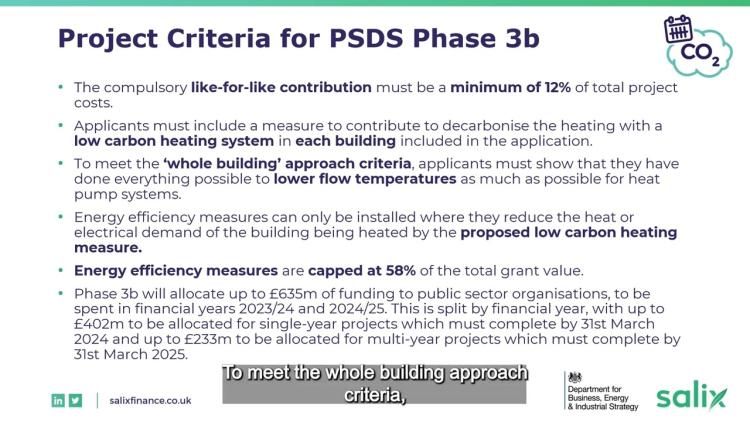Phase 3b Public Sector Decarbonisation Scheme
Project criteria
Eligible organisations were able to apply for grant funding for projects which meet the below compliance criteria:
- Applicants must have and be using a fossil-fuelled heating system.
- The heating system in question should be coming to the end of its useful life.
- Applications must include a measure to contribute to decarbonising the heating with a low carbon heating source in each building included in the application. This new low carbon heating system, alongside the energy efficiency measures installed, must meet the heat demand of the original end of life fossil fuel heating system.
- Applicants can include energy efficiency measures and other enabling works where they reduce the heat or electrical demand of the building being heated by the proposed low carbon heating measure. Energy efficiency measures funded through the Public Sector Decarbonisation Scheme will be capped at 58% of the grant value.
- The funding provided to save a tonne of direct carbon (tCO2e) over the lifetime of the project must be no more than £325 the Carbon Cost Threshold, which is automatically calculated by the Support Tool in the Grant Application Form.
- Just as for Phase 3a of the Public Sector Decarbonisation Scheme, Phase 3b Public Sector Decarbonisation Scheme is primarily for capital works, however external consultancy and management fees may be included. Existing employee costs or any costs previously incurred cannot be included.
- Reasonable enabling and ancillary works may be included in the application, provided they are directly linked to the core technologies being installed, and these will be reviewed for value for money.
- Individual applications can be to any value and there is not an upper cap. However as previously referenced, Applicants must demonstrate that they can deliver within the funding timescales.
- Applicants must either own the building that the funding is being used to upgrade or have a long-term lease arrangement where the tenancy agreement places the responsibility for the operation and maintenance of the building services on the Applicant.
- Applicants must contribute the cost for a like-for-like replacement at a minimum of 12% of the total project costs - like-for-like costs over 12% should still be contributed by the Applicant in full.
- Single year projects must be complete by Sunday 31 March 2024. Multi-year projects must be complete by Monday 31 March 2025. Funding is not available for projects that cannot deliver to this timeframe, and projects which do not complete before these completion dates will be liable for any project costs incurred after this date.
The low carbon heating technology solutions should, wherever possible, be complemented with other measures that will reduce the level of heat demand, such as building fabric insulation, windows and heat recovery systems. Additional measures to reduce high electrical load can also be considered, but only carbon savings from the measures related to direct onsite emissions will count toward carbon compliance criteria. These measures can only be installed where they reduce the heat or electrical demand of the building being heated by the proposed low carbon heating measure.
The Salix Phase 3b Public Sector Decarbonisation Scheme Application Form will calculate the eligible grant value under these new criteria and can be downloaded below.
Applicants were encouraged to take a ‘whole building’ approach to decarbonising their heating. This is where all the factors that contribute to a building’s energy consumption are considered together to identify the most cost-effective way to achieve the objective. For example, investment in improving the insulation levels of the building fabric will reduce the overall size of the low carbon heating plant required, as well as save on fuel bills.
Also, investment in reducing the peak electricity consumption, such as through installation of more energy efficient lighting, can reduce the need to upgrade a building’s electrical infrastructure to accommodate the installation of a heat pump. Applications are to be assessed against how effectively the total energy use of a building has been considered when selecting measures to be installed.
Eligible measures are split into four distinct areas and a list can be found in the Guidance Notes.
Measure Definitions

This video is designed to take you through the eligibility and criteria for Phase 3b of the Public Sector Decarbonisation Scheme.
Other pages in this section
- Key dates
- Latest update for Applicants
- Monthly Monitoring Report and forecasting
- Change requests
- Requesting funds from Salix
- What is new?
- Eligibility
- Consortium Applications
- Project criteria
- Tools and Resources
- Assessment process
- Terms and Conditions & Privacy Notice
- Completing your project
- Frequently asked questions
- Requesting final 2023-24 payment from Salix
